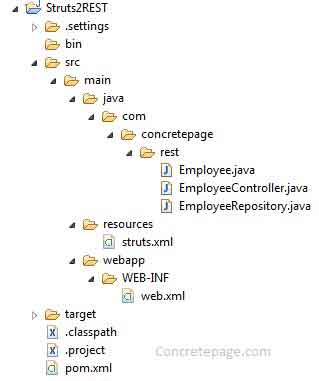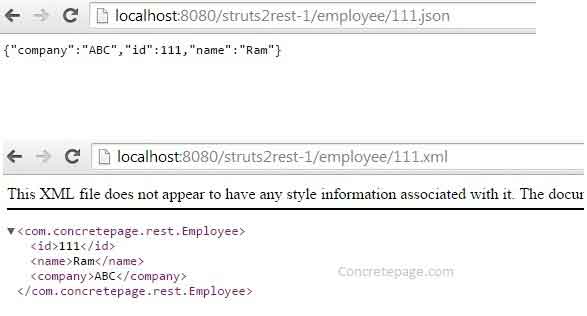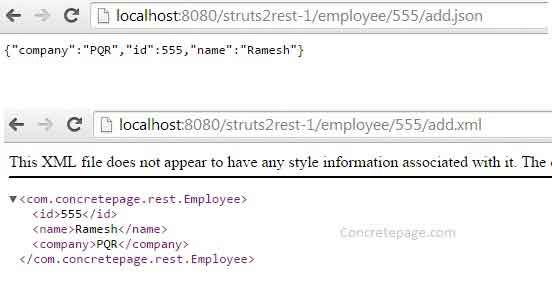Struts 2 + REST Web Service Integration Example
January 04, 2015
This page will provide the Struts 2 and REST web service integration example. Struts 2 provide REST plugin to implement REST web service. Parent package should be rest-default. Conventionally action class name is written with Controller suffix. Struts 2 REST web service supports different content-type response. To get response as JSON, use json extension and to get XML response, use xml extension. In the example we have an employee repository REST web service. For the given employee id in REST URL, employee profile is retuned by the application.
Required Software to Run Application
To run the example, we need below software.1. Java 7
2. Tomcat 7
3. Eclipse
4. Maven
Project Structure in Eclipse
Find the project structure in eclipse for struts 2 and REST web service integration.
pom.xml: Struts 2 REST Plugin
To resolve struts 2 REST API, we need the below plugin in our pom.xmlpom.xml
<project xmlns="http://maven.apache.org/POM/4.0.0" xmlns:xsi="http://www.w3.org/2001/XMLSchema-instance" xsi:schemaLocation="http://maven.apache.org/POM/4.0.0 http://maven.apache.org/maven-v4_0_0.xsd"> <modelVersion>4.0.0</modelVersion> <groupId>com.concretepage</groupId> <artifactId>struts2rest</artifactId> <packaging>war</packaging> <version>1</version> <name>Struts2Rest</name> <dependencies> <dependency> <groupId>org.apache.struts</groupId> <artifactId>struts2-convention-plugin</artifactId> <version>2.3.20</version> </dependency> <dependency> <groupId>org.apache.struts</groupId> <artifactId>struts2-rest-plugin</artifactId> <version>2.3.20</version> </dependency> </dependencies> </project>
struts.xml : Configure Convention Plugin
Find the struts.xml in which struts convention plugin is configured.struts.xml
<?xml version="1.0" encoding="UTF-8" ?>
<!DOCTYPE struts PUBLIC
"-//Apache Software Foundation//DTD Struts Configuration 2.3//EN"
"http://struts.apache.org/dtds/struts-2.3.dtd">
<struts>
<constant name="struts.convention.action.suffix" value="Controller"/>
<constant name="struts.convention.action.mapAllMatches" value="true"/>
<constant name="struts.convention.default.parent.package" value="rest-default"/>
<constant name="struts.convention.package.locators" value="rest"/>
</struts>
<constant name="struts.convention.action.suffix" value="Controller"/>: Defines a suffix for action class. Conventionally action class for REST web service has Controller suffix and this suffix will not be included in URL.
<constant name="struts.convention.action.mapAllMatches" value="true"/>: mapAllMatches can be true or false.
<constant name="struts.convention.default.parent.package" value="rest-default"/>: To support REST web service, struts 2 uses rest-default as parent package.
<constant name="struts.convention.package.locators" value="rest"/>: Locator is the last word of the package within which controller action class resides. In our class, it is rest.
Create Employee Repository
For the demo application, we are creating an employee repository. First find the employee class.Employee.java
package com.concretepage.rest;
public class Employee {
private Integer id;
private String name;
private String company;
public Employee(Integer id, String name, String company){
this.id =id;
this.name = name;
this.company = company;
}
public Integer getId() {
return id;
}
public void setId(Integer id) {
this.id = id;
}
public String getName() {
return name;
}
public void setName(String name) {
this.name = name;
}
public String getCompany() {
return company;
}
public void setCompany(String company) {
this.company = company;
}
}
EmployeeRepository.java
package com.concretepage.rest;
import java.util.HashMap;
import java.util.Map;
public class EmployeeRepository {
private static Map<String,Employee> map = new HashMap<String,Employee>();
public EmployeeRepository(){
map.put("111", new Employee(111, "Ram", "ABC"));
map.put("222", new Employee(222, "Shyam", "EFG"));
map.put("333", new Employee(333, "Mohan", "XYZ"));
}
public Employee getEmployeeById(String id){
return map.get(id);
}
public Map<String,Employee> findAllEmployee(){
return map;
}
}
Create Controller Action Class: Implement ModelDriven
Find the controller class. The class will extend ModelDriven and need to override getModel () method. Whenever a REST URL is hit, this is the method which returns response.EmployeeController.java
package com.concretepage.rest;
import java.util.Map;
import org.apache.struts2.rest.DefaultHttpHeaders;
import org.apache.struts2.rest.HttpHeaders;
import com.opensymphony.xwork2.ModelDriven;
public class EmployeeController implements ModelDriven<Object>{
private static final long serialVersionUID = 1L;
private String id;
private Object model;
private EmployeeRepository employeeRepository = new EmployeeRepository();
private static Map<String,Employee> map;
{
map = employeeRepository.findAllEmployee();
}
public HttpHeaders index() {
model = map;
return new DefaultHttpHeaders("index").disableCaching();
}
public String add(){
Integer empId = Integer.parseInt(id);
Employee emp = new Employee(empId,"Ramesh", "PQR");
model = emp;
return "SUCCESS";
}
public String getId() {
return id;
}
public void setId(String id) {
model = employeeRepository.getEmployeeById(id);
this.id = id;
}
@Override
public Object getModel() {
return model;
}
}
http://localhost:8080/struts2rest-1/employee.json
http://localhost:8080/struts2rest-1/employee.xml
Look at the URL. employee has been taken from EmployeeController class. Suffix is ignored. The default method is index(). To fetch JSON response, use json extension and to fetch xml response, use xml extension.
2. URL for id: Now find other URLs for id setter and getter.
http://localhost:8080/struts2rest-1/employee/111.json
http://localhost:8080/struts2rest-1/employee/111.xml
To pass any input value, there must an id property and we need to create setter and getter method for the id.
3. URL for add(): To call our own method, create a method like add(). This method will be called after id setter and getter. The value 555 in the URL will be assigned to id. The URL will be as below.
http://localhost:8080/struts2rest-1/employee/555/add.json
http://localhost:8080/struts2rest-1/employee/555/add.xml
This url will call add() method and return data assigned to model.
web.xml for Application
Find the web.xml for struts 2.web.xml
<!DOCTYPE web-app PUBLIC
"-//Sun Microsystems, Inc.//DTD Web Application 2.3//EN"
"http://java.sun.com/dtd/web-app_2_3.dtd" >
<web-app>
<display-name>Struts 2 REST Web Service</display-name>
<filter>
<filter-name>struts2</filter-name>
<filter-class>org.apache.struts2.dispatcher.ng.filter.StrutsPrepareAndExecuteFilter</filter-class>
<init-param>
<param-name>actionPackages</param-name>
<param-value>com.concretepage.action</param-value>
</init-param>
</filter>
<filter-mapping>
<filter-name>struts2</filter-name>
<url-pattern>/*</url-pattern>
</filter-mapping>
</web-app>
Output
1. JSON Response of the URL http://localhost:8080/struts2rest-1/employee/111.json
{"company":"ABC","id":111,"name":"Ram"}
<com.concretepage.rest.Employee> <id>111</id> <name>Ram</name> <company>ABC</company> </com.concretepage.rest.Employee>

{"company":"PQR","id":555,"name":"Ramesh"}
<com.concretepage.rest.Employee> <id>555</id> <name>Ramesh</name> <company>PQR</company> </com.concretepage.rest.Employee>



